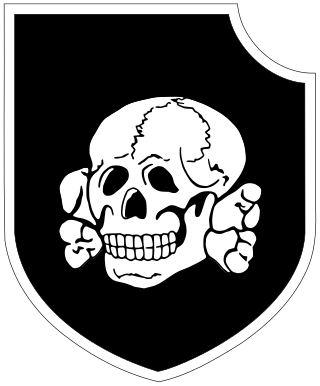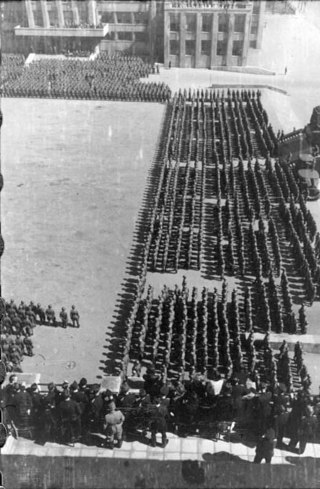Army Group North was a German strategic formation, commanding a grouping of field armies during World War II. The German Army Group was subordinated to the Oberkommando des Heeres (OKH), the German army high command, and coordinated the operations of attached separate army corps, reserve formations, rear services and logistics, including the Army Group North Rear Area.

The 3rd SS Panzer Division "Totenkopf" was an elite division of the Waffen-SS of Nazi Germany during World War II, formed from the Standarten of the SS-TV. Its name, Totenkopf, is German for "death's head" – the skull and crossbones symbol – and it is thus sometimes referred to as the Death's Head Division.
Security Divisions were German rear-area military units engaged in Nazi security warfare in occupied Europe during World War II. Almost all divisions were employed in areas on the Eastern front with the exception of the 325th Security Division which operated within Occupied France. The units were tasked with fighting local partisans, intelligience and counter-insurgency against resistance groups, rounding up Jews and other ethnic groups as part of The Holocaust, and conducting punitive actions in civilian areas.
Heinrich Thoma was a German general during World War II. In October 1941 while a regimental commander in the 296th Infantry Division during Operation Barbarossa, the Axis invasion of the Soviet Union, he was a recipient of the Knight's Cross of the Iron Cross, the highest award in the military and paramilitary forces of Nazi Germany during World War II. From June 1942 until the end of the war he commanded rear area and replacement divisions, and was deputy commander of a military district. As a prisoner of war he died in the Soviet Union in 1948.
Army Group Rear Area Command was an area of military jurisdiction behind each of the three Wehrmacht army groups from 1941, the German invasion of the Soviet Union in Operation Barbarossa, through 1944 when the pre-war territories of the Soviet Union were recovered. The areas were sites of mass murder during the Holocaust and other crimes against humanity targeting the civilian population.
The Police Regiment South was a formation of the German Order Police, the German national uniformed police force, during the Nazi era. During Operation Barbarossa, it was subordinated to the Schutzstaffel (SS) and deployed in German-occupied territories, specifically the Army Group South Rear Area. In July 1942, its three constituent battalions were redesignated as the 10th Police Regiment.
Army Group South Rear Area was one of the three Army Group Rear Area Commands, established during the 1941 German invasion of the Soviet Union. Commanded by General Karl von Roques, it was an area of military jurisdiction behind Wehrmacht's Army Group South.
The 454th Security Division was a rear-security division in the Wehrmacht of Nazi Germany. The unit was deployed in German-occupied areas of the Soviet Union, in the Army Group South Rear Area.
The 444th Security Division was a rear-security division in the Wehrmacht of Nazi Germany. The unit was deployed in German-occupied areas of the Soviet Union, in the Army Group South Rear Area.
The 285th Security Division was a rear-security division in the Wehrmacht of Nazi Germany. The unit was deployed in German-occupied areas of the Soviet Union, in the Army Group North Rear Area.

In German military history, Bandenbekämpfung, also referred to as Nazi security warfare during World War II, refers to the concept and military doctrine of countering resistance or insurrection in the rear area during wartime through extreme brutality. The doctrine provided a rationale for disregarding the established laws of war and for targeting of any number of groups, from armed guerrillas to the civilian population, as "bandits" or "members of gangs". As applied by the German Empire and later by Nazi Germany, it became instrumental in the mass crimes against humanity committed by the two regimes, including the Herero and Namaqua genocide and the Holocaust.
The Police Battalion 303 was a formation of the German Order Police during the Nazi era. During Operation Barbarossa, it was subordinated to the SS and deployed in German-occupied areas, specifically the Army Group Centre Rear Area, of the Soviet Union, as part of Police Regiment South. Alongside detachments from the Einsatzgruppen of the SD and the 1st SS Infantry Brigade of the Waffen-SS, it perpetrated mass murder in the Holocaust and was responsible for large-scale crimes against humanity targeting civilian populations.
The Police Battalion 45 was a formation of the German Order Police during the Nazi era. During Operation Barbarossa, it was subordinated to the SS and deployed in German-occupied areas, specifically the Army Group Centre Rear Area, of the Soviet Union, as part of Police Regiment South. Alongside detachments from the Einsatzgruppen of the SD and the 1st SS Infantry Brigade of the Waffen-SS, it perpetrated mass murder in the Holocaust and was responsible for large-scale crimes against humanity targeting civilian populations.

The Order Police battalions were militarised formations of the Nazi German Ordnungspolizei. During World War II, they were subordinated to the SS and deployed in German-occupied areas, specifically the Army Group Rear Areas and territories under German civilian administration. Alongside detachments from the Einsatzgruppen and the Waffen-SS, these units perpetrated mass murder of the Jewish population and were responsible for large-scale crimes against humanity targeting civilian populations.

The 62nd Infantry Division was an infantry division of the German Heer during World War II. It was formed in Wehrkreis VIII (Silesia) in August 1939. After heavy casualties in March 1944, it was first briefly reassembled in August 1944 and then reorganized into the 62nd Volksgrenadier Division, formed from units assembled for the planned 583rd Volksgrenadier Division, on 22 September 1944. The dissolution of 62nd Infantry Division was declared on 9 October 1944. 62nd Volksgrenadier Division remained operational until it was trapped in the Ruhr Pocket and forced to surrender by American forces in April 1945.
The 153rd Grenadier Division, sometimes referred to as 153rd Infantry Division in Wehrmacht documents, was an infantry division of the German Heer during World War II. It was founded under the name Division No. 153, and also carried the names Commander of Reserve Troops III, 153rd Reserve Division, and 153rd Field Training Division. It was first deployed in August 1939, received its first redesignation in December 1939, was renamed twice more in 1942, was destroyed by forces of the Soviet Union twice and then redeployed, and was redesignated a final time in 1945.
The 217th Infantry Division was an infantry division of the German Heer during World War II. It later became the Division Group 217. It is also listed as the 217th Volksgrenadier Division.

The XXVI Army Corps was a Wehrmacht army corps during World War II. It existed from 1939 to 1945. It was also known as Corps Wodrig during the Invasion of Poland.
The 403rd Security Division was a rear-security division in the Wehrmacht of Nazi Germany. Throughout the war, the unit was mainly deployed in the Army Group South Rear Area behind the Eastern Front, which was a large, German-occupied area of the Soviet Union. During the whole war, the 403rd Security Division was used throughout the war mainly on the Eastern Front for security tasks in the rear army area, such as capturing scattered Soviet soldiers and commissars. Further anti-Semitic measures, such as confiscations, removal of functions, the formation of "purely" Jewish houses, followed.
The 328th Infantry Division was the name of two distinct infantry divisions of the German army during World War II. The first, simply dubbed 328th Infantry Division, existed between 1941 and 1943, while the second, designated 328th Infantry Division "Zealand", existed for just under two months in 1945.





